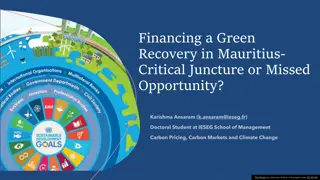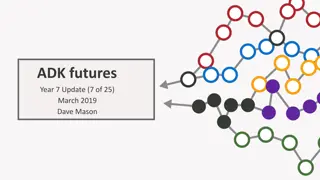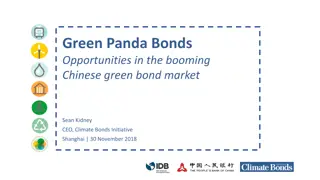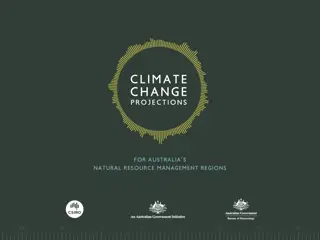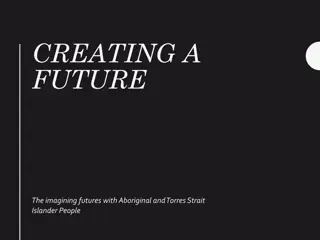Understanding Climate Finance in Green Futures
Explore the significance of Climate Finance in Green Futures through examples from Thailand and Costa Rica. Learn about mitigation and adaptation efforts, funding sources like the Green Climate Fund, and career opportunities in this pivotal sector. Discover how Climate Finance addresses climate change impacts and supports sustainable projects worldwide.
Download Presentation

Please find below an Image/Link to download the presentation.
The content on the website is provided AS IS for your information and personal use only. It may not be sold, licensed, or shared on other websites without obtaining consent from the author. Download presentation by click this link. If you encounter any issues during the download, it is possible that the publisher has removed the file from their server.
E N D
Presentation Transcript
Green Finance, Green Futures Lesson 3: Climate Finance and me Click 'Slide Show', then 'from Click 'Slide Show', then 'from beginning' to start this lesson start this lesson beginning' to
In lesson 3 we will... 3.1 Introduce the concept of Climate Finance 3.2 Outline the importance of COP26 3.3 Discuss possible career opportunities in Green Finance 3.4 Summarise the past 3 sessions
3.1 Climate Finance Global Approaches to Green Finance
Climate Finance Climate Finance is an important area of Green Finance that is particularly concerned with transnational funding to manage climate change Developing countries who have contributed least to causing global warming, are often impacted most by the negative consequences. Climate Finance refers to public (governments) and private financing of projects focusing specifically on climate change mitigation and adaptation in developing countries. Climate Change Mitigation: This refers to avoiding and reducing emissions of greenhouse gases into the atmosphere. Adaptation to Climate Change: Efforts to prepare and adjust to current and future impacts of climate change.
Click here to hear more about the purpose of Climate Finance from a United Nations representative.
Adaptation Project Example: Thailand The Green Climate Fund is funding a project aimed at enhancing resilience in Thailand through effective water management and sustainable agriculture. Climate Change has caused an increase in the frequency of heavy rains in the Chao Phraya basin in Thailand, increasing the risk of severe floods. There is also risk of drought during the dry season linked to rising temperatures. The Green Climate Fund has provided funding for flood control and irrigation infrastructure , ecosystem-based water management measures and climate-informed planning. Therefore, finance is needed to help this region ADAPT to this consequence of climate change.
Mitigation Project Example: Costa Rica Without mitigation measures, emissions from the transport sector in Costa Rica are estimated to rise by 44% by 2050. To help prevent these emissions, the Green Climate Fund is funding a project to install an electric light rail transit system in San Jos , the capital of Costa Rica. This new rail system will be powered by more than 98% renewable energy. Emissions rise by 44% by 2050 If we do nothing Electric train system powered by renewable energy will prevent those emissions being released. Mitigation Funding Source: Green Climate Fund https://www.greenclimate.fund/project/fp166
Who is involved in Climate Finance? Climate finance networks have been established to allow money to flow to adaptation and mitigation projects. There are several key players in Climate Finance Governments International Climate Funds Governments can contribute money through funds including the Green Climate Fund (GCF), Global Environment Facility and Adaptation Fund. Governments can provide public money for climate finance. At COP15 in 2009 wealthy countries agreed to collectively provide $100 billion a year in climate finance, however this target has not been met. Private Sector Multilateral Development Banks These are international financial institutions consisting of member from multiple nations with the purpose of encouraging economic development in poorer nations. They provide loans and grants to countries for projects. The Private Financial sector (Banks, Investors, Insurers) also mobilise money towards sustainable development. The United Nations Environment Programme Finance Initiative (UNEP FI) supports the private finance sector to do this.
As mentioned in the previous slide, International Climate Funds are an important way for climate finance to flow between countries. Click here to hear Eduardo Freitas, the regional manager for Africa, discuss the Green Climate Fund.
3.2 What is COP26? And why is it important?
What is COP26? COP (Conference of the Parties) is the decision-making body which reviews the progress of the implementation of the United Nations Framework Convention on Climate Change. Since 1995,countries have met to discuss how the world addressing climate change and what needs to be done 197 nations ('parties') have signed up to the framework convention. The 26th COP is being held in Glasgow Some goals of COP26 are to: Work together to deliver the Paris Agreement Secure global net zero by 2050 and keep 1.5 degrees within reach. Adapt to protect communities and natural habitats. Mobilise Finance This is required for all the above!
Activity What do you hope COP26 will achieve? What do you hope COP26 will achieve? Film a short 30 second video and send it to business-rsm@glasgow.ac.uk We will post a selection of these videos on the Green Finance, Green Futures website
The COP Climate Finance Target At COP15 (2009) wealthy countries agreed to collectively provide $100 billion a year in climate finance: but this target has not been met According to the report, only Norway, Sweden and Germany have contributed their full amount towards the climate finance target A recent report by the Overseas Development Institute (ODI) suggests each developed country s 'fair share' of the climate finance target could be determined by three metrics: gross national income, population and cumulative cardon dioxide emissions The ODI report encourages the distribution of climate finance targets between countries to be a topic of negotiation so that countries can be held responsible
Click here to hear more from the authors of the ODI report.
3.3 Green Finance, Green Futures and Me Careers in Green Finance
Other careers and Green Finance In the future it is likely that all jobs and careers will be impacted by Green finance in some way For example, green finance may Be important in how you save for your retirement or a pension Influence where you work based on the company's ESG score Result in you working in teams made up of scientists, economists and policymakers to create and finance environmental innovations Fund new and more environmental ways of commuting to and from your workplace Make you decide what bank you pay your wages into
Click here to hear Omar Shaikh, Managing Director of the Global Ethical Finance Initiative (GEFI) on how green finance practices might affect your future career.
Careers in Green Finance The rise in green finance has led to a lot of career opportunities These can include Advising clients about where to invest, such as 'net zero' companies Independent financial advisors working in banks with individual customers looking for sustainable pension schemes Developing financial products that are environmentally sustainable Ensuring your company have financial climate change regulations and policy Working within government or a regulatory body to support green finance Analysing data or using AI to evaluate and assess financial risks and opportunities surrounding climate change There are also likely to be new jobs emerging in the future to support green finance that don't yet exist!
Green Finance Jobs at the Bank of England As a key financial regulator, a number of people in the Bank of England work in supporting regulated banks to work towards best practice sustainable financial outcomes. As an organization, there are also committees and individuals responsible for ensuring green action is embedded in everything they do. This does not only include their regulatory work, but how they source their own products and services in an environmentally sound way.
Activity Careers in Green Finance Watch the two videos below to hear experts from Government, academia and the public and private sectors talk aboutcareers and working in green finance Click here to see how there are opportunities emerging in the green finance sector. Click here to hear how and why they got involved in Green Finance. Can you identify two reasons why it is an exciting time to work in Green Finance? Go to the next slide for some reasons...
Activity Careers in Green Finance Some reasons for a career in Green Finance include Being able to align career with your personal values Being part of a broader change in how society views the economy Having the opportunity to work in a new and growing sector Supporting others with 'green' expertise (such as engineering) by finding ways to provide financial resource their ideas
Finally... Questions for the live panel! On the 11th November, 10-11am, you will have the opportunity to ask an expert panel any questions you have about green finance! Send your questions to business-rsm@glasgow.ac.uk by 8th November What are useful subjects to study?
3.4 Summary of all three lessons
Lesson 1 Summary The climate crisis poses a real threat and without serious efforts we are very likely to exceed 1.5 C global warming, potentially event the 2 C limit set by the Paris Agreement To prevent this, we need to cut global emissions, which means transitioning to a decarbonised world (amongst other changes) The challenge is that the economic system, and our day-to-day lives in general, are currently very heavily reliant on environmentally unsustainable activities such as fossil fuels Finance is the engine of the global economy. So, if we can change finance to be more green , it will enable us to steer the global economic system towards a sustainable future.
Lesson 2 Summary Green finance refers to finance that mobilises money towards environmentally conscious products and services. This money can also help to scale businesses which are building a more sustainable economy. Examples of green finance include instruments such as green bonds and sustainable funds, and public investment such as The Bank (Scottish National Investment Bank). Disclosure regulations are important for holding companies and investors to account in terms of their impact on the environment. However, the issue of what metrics should be used to define what is green is complicated and is current topic of discussion in the industry
Lesson 3 Summary Climate Finance involves public and private financing of projects focusing specifically on climate change mitigation and adaptation. The target for developed nations to collectively provide $100 billion of climate finance a year has not been met so far. COP26 provides an opportunity for countries to negotiate how more climate finance can be mobilised. This is vital to tackle the increasing pressures faced by developing countries due to climate change. There are a growing number of opportunities to work towards a career in Green Finance
For more information For more information contact business contact business- - rsm@glasgow.ac.uk rsm@glasgow.ac.uk








